Effects of Exercise Intervention on Mitochondrial Stress Biomarkers in Metabolic Syndrome Patients: A Randomized Controlled Trial
Abstract
1. Introduction
2. Materials and Methods
2.1. Study Design and Ethical Approval
2.2. Participants
2.2.1. Patients with Metabolic Syndrome
2.2.2. Age-Matched Healthy Volunteers
2.3. Randomization and Blinding
2.4. Intervention Study
2.4.1. Exercise Intervention Group
2.4.2. Usual Care Control Group
2.5. Outcome Measures
2.5.1. Blood Collection and Biochemical Measurements
2.5.2. Kinanthropometric Profiles
2.6. Statistical Analysis
3. Results
3.1. MetS Women Have Higher Serum FGF21, GDF15, and ANGPTL6 Levels Than Age-Matched Healthy Women
3.2. Characteristics and Disposition of the Participants with Metabolic Syndrome
3.3. Effect of Exercise Intervention on the Study Outcomes
3.3.1. Primary Outcomes: Exercise Suppresses Serum FGF21, GDF15, and ANGPTL6 Levels in MetS Women
3.3.2. Improved Kinanthropometric Parameters in Exercising MetS Women
3.3.3. Blood Biochemical Profiles and the Number of Metabolic Syndrome Components
3.3.4. Relationship between Changes in Metabolism-Related Humoral Factors and Clinical Parameters
4. Discussion
5. Conclusions
Supplementary Materials
Author Contributions
Funding
Institutional Review Board Statement
Informed Consent Statement
Data Availability Statement
Acknowledgments
Conflicts of Interest
Appendix A
| Variables | Age-Matched Healthy Control | Metabolic Syndrome Patients | p-Value |
|---|---|---|---|
| N | 12 | 30 | |
| Age (year) | 58.3 ± 6.0 | 59.4 ± 10.3 | 0.541 |
| Body mass index (kg/m2) | 23.7 ± 2.6 | 29.2 ± 3.8 | 0.004 |
| Waist circumference (cm) | 78.1 ± 6.0 | 90.7 ± 9.4 | <0.001 |
| Body fat (%) | 30.3 ± 7.2 | 37.4 ± 5.9 | 0.009 |
| ALM (kg) | 16.6 ± 1.8 | 16.0 ± 2.6 | 0.442 |
| ALM/ht2 | 6.56 ± 0.36 | 6.59 ± 0.79 | 0.876 |
| Handgrip strength (kg) | 28.2 ± 4.1 | 27.3 ± 4.2 | 0.514 |
| Systolic blood pressure (mmHg) | 118.3 ± 10.6 | 132.4 ± 11.5 | <0.001 |
| Diastolic blood pressure (mmHg) | 83.4 ± 9.3 | 84.8 ± 10.5 | 0.729 |
| Triglyceride (mg/dL) | 111.0 (81.5–171.5) | 126.0 (86.5–183.0) | 0.059 |
| Total cholesterol (mg/dL) | 162.3 ± 28.0 | 195.5 ± 26.3 | 0.008 |
| HDL-cholesterol (mg/dL) | 59.0 (45.0–67.8) | 44.5 (40.0–53.0) | 0.019 |
| LDL-cholesterol (mg/dL) | 141.8 ± 22.7 | 131.3 ± 24.8 | 0.265 |
| Fasting glucose (mg/dL) | 85.5 (75.5–92.8) | 102.2 (98.6–109.4) | 0.011 |
| AST (IU/L) | 21.0 (16.5–23.8) | 17.0 (13.8–23.0) | 0.253 |
| ALT (IU/L) | 15.0 (10.5–19.8) | 22.0 (18.5–25.3) | 0.023 |
| γ-GT (IU/L) | 13.0 (10.0–17.3) | 20.0 (12.8–27.0) * | 0.062 |
| Variables | FGF21 (pg/mL) | GDF15 (pg/mL) | ANGPTL6 (ng/mL) | Variables | FGF21 (pg/mL) | GDF15 (pg/mL) | ANGPTL6 (ng/mL) | ||
|---|---|---|---|---|---|---|---|---|---|
| Age (year) | r | −0.067 | 0.622 | −0.159 | TG (mg/dL) | r | 0.525 | 0.041 | 0.276 |
| p | 0.729 | <0.001 | 0.409 | p | 0.003 | 0.834 | 0.147 | ||
| BMI (kg/m2) | r | −0.014 | 0.026 | 0.127 | TC (mg/dL) | r | 0.138 | −0.041 | 0.063 |
| p | 0.941 | 0.893 | 0.513 | p | 0.477 | 0.833 | 0.745 | ||
| WC (cm) | r | 0.026 | 0.008 | 0.218 | HDL-C (mg/dL) | r | −0.292 | −0.144 | −0.268 |
| p | 0.893 | 0.968 | 0.256 | p | 0.124 | 0.457 | 0.159 | ||
| Body fat (%) | r | 0.097 | 0.129 | 0.087 | LDL-C (mg/dL) | r | 0.12 | −0.035 | 0.072 |
| p | 0.616 | 0.504 | 0.652 | p | 0.534 | 0.857 | 0.709 | ||
| BFM (kg) | r | 0.073 | 0.044 | 0.186 | Glucose (mg/dL) | r | 0.386 | −0.043 | 0.201 |
| p | 0.707 | 0.821 | 0.333 | p | 0.039 | 0.826 | 0.296 | ||
| ALM (kg) | r | −0.027 | −0.387 | 0.242 | Insulin(µIU) | r | 0.461 | 0.021 | 0.464 |
| p | 0.889 | 0.038 | 0.205 | p | 0.012 | 0.913 | 0.011 | ||
| ALM/BFM | r | −0.069 | −0.201 | −0.033 | HOMA-IR | r | 0.509 | 0.039 | 0.449 |
| p | 0.72 | 0.295 | 0.865 | p | 0.005 | 0.841 | 0.014 | ||
| ALM/ht2 (kg/m2) | r | −0.110 | −0.230 | 0.197 | HOMA-β (%) | r | 0.1 | −0.016 | 0.293 |
| p | 0.571 | 0.23 | 0.307 | p | 0.606 | 0.935 | 0.123 | ||
| ALM/BMI | r | 0.042 | −0.424 | 0.194 | HbA1c (%) | r | 0.263 | 0.147 | 0.107 |
| p | 0.827 | 0.022 | 0.313 | p | 0.168 | 0.447 | 0.579 | ||
| SBP (mmHg) | r | 0.24 | −0.179 | 0.207 | HbA1c (mmol/mol) | r | 0.259 | 0.176 | 0.093 |
| p | 0.21 | 0.352 | 0.282 | p | 0.174 | 0.362 | 0.631 | ||
| DBP (mmHg) | r | 0.331 | −0.177 | 0.179 | AST (IU/L) | r | −0.099 | 0.136 | 0.046 |
| p | 0.079 | 0.359 | 0.353 | p | 0.61 | 0.483 | 0.815 | ||
| HGS (kg) | r | −0.132 | −0.478 | −0.098 | ALT (IU/L) | r | 0.218 | −0.097 | 0.391 |
| p | 0.496 | 0.009 | 0.614 | p | 0.257 | 0.615 | 0.036 | ||
| Long jump (cm) | r | −0.226 | −0.368 | 0.059 | γ-GT (IU/L) | r | 0.323 | −0.016 | −0.101 |
| p | 0.299 | 0.084 | 0.788 | p | 0.087 | 0.936 | 0.602 | ||
| Sit-up (n/30 sec) | r | −0.148 | −0.258 | −0.117 | hs-CRP (mg/L) | r | 0.016 | 0.051 | 0.109 |
| p | 0.5 | 0.235 | 0.595 | p | 0.934 | 0.793 | 0.573 | ||
| 10 m shuttle run (sec) | r | 0.127 | 0.154 | 0.114 | Uric acid (mg/dL) | r | 0.251 | −0.135 | 0.395 |
| p | 0.562 | 0.483 | 0.606 | p | 0.188 | 0.485 | 0.034 | ||
| 20 m pacer (n) | r | −0.129 | −0.324 | −0.087 | Leptin (ng/mL) | r | 0.033 | −0.013 | 0.266 |
| p | 0.558 | 0.132 | 0.693 | p | 0.863 | 0.947 | 0.164 |
References
- Low, S.; Khoo, K.C.J.; Wang, J.; Irwan, B.; Sum, C.F.; Subramaniam, T.; Lim, S.C.; Wong, T.K.M. Development of a metabolic syndrome severity score and its association with incident diabetes in an Asian population-results from a longitudinal cohort in Singapore. Endocrine 2019, 65, 73–80. [Google Scholar] [CrossRef]
- Mottillo, S.; Filion, K.B.; Genest, J.; Joseph, L.; Pilote, L.; Poirier, P.; Rinfret, S.; Schiffrin, E.L.; Eisenberg, M.J. The metabolic syndrome and cardiovascular risk a systematic review and meta-analysis. J. Am. Coll. Cardiol. 2010, 56, 1113–1132. [Google Scholar] [CrossRef] [PubMed]
- DeBoer, M.D.; Filipp, S.L.; Gurka, M.J. Use of a Metabolic Syndrome Severity Z Score to Track Risk During Treatment of Prediabetes: An Analysis of the Diabetes Prevention Program. Diabetes Care 2018, 41, 2421–2430. [Google Scholar] [CrossRef] [PubMed]
- Alberti, K.G.; Zimmet, P.; Shaw, J.; IDF Epidemiology Task Force Consensus Group. The metabolic syndrome—A new worldwide definition. Lancet 2005, 366, 1059–1062. [Google Scholar] [CrossRef]
- James, A.M.; Collins, Y.; Logan, A.; Murphy, M.P. Mitochondrial oxidative stress and the metabolic syndrome. Trends Endocrinol. Metab. 2012, 23, 429–434. [Google Scholar] [CrossRef]
- Bhatti, J.S.; Bhatti, G.K.; Reddy, P.H. Mitochondrial dysfunction and oxidative stress in metabolic disorders—A step towards mitochondria based therapeutic strategies. Biochim. Biophys. Acta Mol. Basis Dis. 2017, 1863, 1066–1077. [Google Scholar] [CrossRef]
- Alemany, M. Utilization of dietary glucose in the metabolic syndrome. Nutr. Metab. 2011, 8, 74. [Google Scholar] [CrossRef] [PubMed]
- Thyfault, J.P.; Krogh-Madsen, R. Metabolic disruptions induced by reduced ambulatory activity in free-living humans. J. Appl. Physiol. 2011, 111, 1218–1224. [Google Scholar] [CrossRef]
- Li, H.; Zhang, J.; Jia, W. Fibroblast growth factor 21: A novel metabolic regulator from pharmacology to physiology. Front. Med. 2013, 7, 25–30. [Google Scholar] [CrossRef]
- Morovat, A.; Weerasinghe, G.; Nesbitt, V.; Hofer, M.; Agnew, T.; Quaghebeur, G.; Sergeant, K.; Fratter, C.; Guha, N.; Mirzazadeh, M.; et al. Use of FGF-21 as a Biomarker of Mitochondrial Disease in Clinical Practice. J. Clin. Med. 2017, 6, 80. [Google Scholar] [CrossRef]
- Chung, H.K.; Ryu, D.; Kim, K.S.; Chang, J.Y.; Kim, Y.K.; Yi, H.S.; Kang, S.G.; Choi, M.J.; Lee, S.E.; Jung, S.B.; et al. Growth differentiation factor 15 is a myomitokine governing systemic energy homeostasis. J. Cell. Biol. 2017, 216, 149–165. [Google Scholar] [CrossRef]
- Boenzi, S.; Diodato, D. Biomarkers for mitochondrial energy metabolism diseases. Essays Biochem. 2018, 62, 443–454. [Google Scholar]
- Kim, S.H.; Kim, K.H.; Kim, H.K.; Kim, M.J.; Back, S.H.; Konishi, M.; Itoh, N.; Lee, M.S. Fibroblast growth factor 21 participates in adaptation to endoplasmic reticulum stress and attenuates obesity-induced hepatic metabolic stress. Diabetologia 2015, 58, 809–818. [Google Scholar] [CrossRef] [PubMed]
- Fujita, Y.; Taniguchi, Y.; Shinkai, S.; Tanaka, M.; Ito, M. Secreted growth differentiation factor 15 as a potential biomarker for mitochondrial dysfunctions in aging and age-related disorders. Geriatr. Gerontol. Int. 2016, 16, 17–29. [Google Scholar] [CrossRef] [PubMed]
- Oike, Y.; Akao, M.; Yasunaga, K.; Yamauchi, T.; Morisada, T.; Ito, Y.; Urano, T.; Kimura, Y.; Kubota, Y.; Maekawa, H.; et al. Angiopoietin-related growth factor antagonizes obesity and insulin resistance. Nat. Med. 2005, 11, 400–408. [Google Scholar] [CrossRef]
- Ebert, T.; Kralisch, S.; Loessner, U.; Jessnitzer, B.; Stumvoll, M.; Fasshauer, M.; Tonjes, A. Relationship between serum levels of angiopoietin-related growth factor and metabolic risk factors. Horm. Metab. Res. 2014, 46, 685–690. [Google Scholar] [CrossRef] [PubMed]
- Namkung, J.; Koh, S.B.; Kong, I.D.; Choi, J.W.; Yeh, B.I. Serum levels of angiopoietin-related growth factor are increased in metabolic syndrome. Metabolism 2011, 60, 564–568. [Google Scholar] [CrossRef] [PubMed]
- McGee, S.L.; Hargreaves, M. Exercise adaptations: Molecular mechanisms and potential targets for therapeutic benefit. Nat. Rev. Endocrinol. 2020, 16, 495–505. [Google Scholar] [CrossRef] [PubMed]
- Durstine, J.L.; Moore, G.E.; Painter, P.L. American College of Sports Medicine. ACSM’s Exercise Management for Persons with Chronic Diseases and Disabilities, 4th ed.; Human Kinetics: Champaign, IL, USA, 2016; 391p. [Google Scholar]
- Stensvold, D.; Tjonna, A.E.; Skaug, E.A.; Aspenes, S.; Stolen, T.; Wisloff, U.; Slordahl, S.A. Strength training versus aerobic interval training to modify risk factors of metabolic syndrome. J. Appl. Physiol. 2010, 108, 804–810. [Google Scholar] [CrossRef]
- Amanat, S.; Sinaei, E.; Panji, M.; MohammadporHodki, R.; Bagheri-Hosseinabadi, Z.; Asadimehr, H.; Fararouei, M.; Dianatinasab, A. A Randomized Controlled Trial on the Effects of 12 Weeks of Aerobic, Resistance, and Combined Exercises Training on the Serum Levels of Nesfatin-1, Irisin-1 and HOMA-IR. Front. Physiol. 2020, 11, 562895. [Google Scholar] [CrossRef]
- Colado, J.C.; Garcia-Masso, X.; Triplett, T.N.; Flandez, J.; Borreani, S.; Tella, V. Concurrent validation of the OMNI-resistance exercise scale of perceived exertion with Thera-band resistance bands. J. Strength Cond. Res. 2012, 26, 3018–3024. [Google Scholar] [CrossRef] [PubMed]
- Haff, G.; Triplett, N.T. National Strength & Conditioning Association (U.S.) Essentials of Strength Training and Conditioning, 4th ed.; Human Kinetics: Champaign, IL, USA, 2016; 735p. [Google Scholar]
- Matthews, D.R.; Hosker, J.P.; Rudenski, A.S.; Naylor, B.A.; Treacher, D.F.; Turner, R.C. Homeostasis model assessment: Insulin resistance and beta-cell function from fasting plasma glucose and insulin concentrations in man. Diabetologia 1985, 28, 412–419. [Google Scholar] [CrossRef] [PubMed]
- Schindler, K.; Vila, G.; Hoppichler, F.; Lechleitner, M.; Luger, A.; Anderwald, C.; Hoefler, J.; Tomasec, G.; Kautzky-Willer, A.; Ludvik, B. The impact of type 2 diabetes on circulating adipokines in patients with metabolic syndrome. Obes. Facts 2012, 5, 270–276. [Google Scholar] [CrossRef]
- Park, B.S.; Yoon, J.S. Relative skeletal muscle mass is associated with development of metabolic syndrome. Diabetes Metab. J. 2013, 37, 458–464. [Google Scholar] [CrossRef]
- Saklayen, M.G. The Global Epidemic of the Metabolic Syndrome. Curr. Hypertens. Rep. 2018, 20, 12. [Google Scholar] [CrossRef]
- Lee, S.E.; Han, K.; Kang, Y.M.; Kim, S.O.; Cho, Y.K.; Ko, K.S.; Park, J.Y.; Lee, K.U.; Koh, E.H.; Taskforce Team of Diabetes Fact Sheet of the Korean Diabetes, A. Trends in the prevalence of metabolic syndrome and its components in South Korea: Findings from the Korean National Health Insurance Service Database (2009–2013). PLoS ONE 2018, 13, e0194490. [Google Scholar] [CrossRef]
- Zhang, X.; Yeung, D.C.; Karpisek, M.; Stejskal, D.; Zhou, Z.G.; Liu, F.; Wong, R.L.; Chow, W.S.; Tso, A.W.; Lam, K.S.; et al. Serum FGF21 levels are increased in obesity and are independently associated with the metabolic syndrome in humans. Diabetes 2008, 57, 1246–1253. [Google Scholar] [CrossRef]
- Choi, J.R.; Kim, J.Y.; Park, I.H.; Huh, J.H.; Kim, K.W.; Cha, S.K.; Park, K.S.; Sohn, J.H.; Park, J.T.; Koh, S.B. Serum Fibroblast Growth Factor 21 and New-Onset Metabolic Syndrome: KoGES-ARIRANG Study. Yonsei Med. J. 2018, 59, 287–293. [Google Scholar] [CrossRef]
- Namkung, J.; Sohn, J.H.; Chang, J.S.; Park, S.W.; Kim, J.Y.; Koh, S.B.; Kong, I.D.; Park, K.S. Increased Serum Angiopoietin-Like 6 Ahead of Metabolic Syndrome in a Prospective Cohort Study. Diabetes Metab. J. 2019, 43, 521–529. [Google Scholar] [CrossRef]
- Itoh, N. FGF21 as a Hepatokine, Adipokine, and Myokine in Metabolism and Diseases. Front. Endocrinol. 2014, 5, 107. [Google Scholar] [CrossRef] [PubMed]
- Kharitonenkov, A.; Dunbar, J.D.; Bina, H.A.; Bright, S.; Moyers, J.S.; Zhang, C.; Ding, L.; Micanovic, R.; Mehrbod, S.F.; Knierman, M.D.; et al. FGF-21/FGF-21 receptor interaction and activation is determined by betaKlotho. J. Cell. Physiol. 2008, 215, 1–7. [Google Scholar] [CrossRef]
- Staiger, H.; Keuper, M.; Berti, L.; Hrabe de Angelis, M.; Haring, H.U. Fibroblast Growth Factor 21-Metabolic Role in Mice and Men. Endocr. Rev. 2017, 38, 468–488. [Google Scholar] [CrossRef]
- Chavez, A.O.; Molina-Carrion, M.; Abdul-Ghani, M.A.; Folli, F.; Defronzo, R.A.; Tripathy, D. Circulating fibroblast growth factor-21 is elevated in impaired glucose tolerance and type 2 diabetes and correlates with muscle and hepatic insulin resistance. Diabetes Care 2009, 32, 1542–1546. [Google Scholar] [CrossRef]
- Li, H.; Fang, Q.; Gao, F.; Fan, J.; Zhou, J.; Wang, X.; Zhang, H.; Pan, X.; Bao, Y.; Xiang, K.; et al. Fibroblast growth factor 21 levels are increased in nonalcoholic fatty liver disease patients and are correlated with hepatic triglyceride. J. Hepatol. 2010, 53, 934–940. [Google Scholar] [CrossRef] [PubMed]
- Shen, J.; Chan, H.L.; Wong, G.L.; Choi, P.C.; Chan, A.W.; Chan, H.Y.; Chim, A.M.; Yeung, D.K.; Chan, F.K.; Woo, J.; et al. Non-invasive diagnosis of non-alcoholic steatohepatitis by combined serum biomarkers. J. Hepatol. 2012, 56, 1363–1370. [Google Scholar] [CrossRef] [PubMed]
- Lin, Z.; Wu, Z.; Yin, X.; Liu, Y.; Yan, X.; Lin, S.; Xiao, J.; Wang, X.; Feng, W.; Li, X. Serum levels of FGF-21 are increased in coronary heart disease patients and are independently associated with adverse lipid profile. PLoS ONE 2010, 5, e15534. [Google Scholar] [CrossRef]
- Ong, K.L.; McClelland, R.L.; Allison, M.A.; Kokkinos, J.; Wu, B.J.; Barter, P.J.; Rye, K.A. Association of elevated circulating fibroblast growth factor 21 levels with prevalent and incident metabolic syndrome: The Multi-Ethnic Study of Atherosclerosis. Atherosclerosis 2019, 281, 200–206. [Google Scholar] [CrossRef] [PubMed]
- Lee, S.Y.; Burns, S.F.; Ng, K.K.C.; Stensel, D.J.; Zhong, L.; Tan, F.H.Y.; Chia, K.L.; Fam, K.D.; Yap, M.M.C.; Yeo, K.P.; et al. Fibroblast Growth Factor 21 Mediates the Associations between Exercise, Aging, and Glucose Regulation. Med. Sci. Sports Exerc. 2020, 52, 370–380. [Google Scholar] [CrossRef] [PubMed]
- Kruse, R.; Vienberg, S.G.; Vind, B.F.; Andersen, B.; Hojlund, K. Effects of insulin and exercise training on FGF21, its receptors and target genes in obesity and type 2 diabetes. Diabetologia 2017, 60, 2042–2051. [Google Scholar] [CrossRef] [PubMed]
- Lin, Z.; Gong, Q.; Wu, C.; Yu, J.; Lu, T.; Pan, X.; Lin, S.; Li, X. Dynamic change of serum FGF21 levels in response to glucose challenge in human. J. Clin. Endocrinol. Metab. 2012, 97, E1224–E1228. [Google Scholar] [CrossRef] [PubMed]
- Kim, K.H.; Kim, S.H.; Min, Y.K.; Yang, H.M.; Lee, J.B.; Lee, M.S. Acute exercise induces FGF21 expression in mice and in healthy humans. PLoS ONE 2013, 8, e63517. [Google Scholar] [CrossRef] [PubMed]
- Cuevas-Ramos, D.; Almeda-Valdes, P.; Meza-Arana, C.E.; Brito-Cordova, G.; Gomez-Perez, F.J.; Mehta, R.; Oseguera-Moguel, J.; Aguilar-Salinas, C.A. Exercise increases serum fibroblast growth factor 21 (FGF21) levels. PLoS ONE 2012, 7, e38022. [Google Scholar] [CrossRef] [PubMed]
- Yang, S.J.; Hong, H.C.; Choi, H.Y.; Yoo, H.J.; Cho, G.J.; Hwang, T.G.; Baik, S.H.; Choi, D.S.; Kim, S.M.; Choi, K.M. Effects of a three-month combined exercise programme on fibroblast growth factor 21 and fetuin-A levels and arterial stiffness in obese women. Clin. Endocrinol. 2011, 75, 464–469. [Google Scholar] [CrossRef]
- Banitalebi, E.; Kazemi, A.; Faramarzi, M.; Nasiri, S.; Haghighi, M.M. Effects of sprint interval or combined aerobic and resistance training on myokines in overweight women with type 2 diabetes: A randomized controlled trial. Life Sci. 2019, 217, 101–109. [Google Scholar] [CrossRef]
- Shabkhiz, F.; Khalafi, M.; Rosenkranz, S.; Karimi, P.; Moghadami, K. Resistance training attenuates circulating FGF-21 and myostatin and improves insulin resistance in elderly men with and without type 2 diabetes mellitus: A randomized controlled clinical trial. Eur. J. Sport. Sci. 2020, 1–14. [Google Scholar] [CrossRef] [PubMed]
- Geng, L.; Liao, B.; Jin, L.; Huang, Z.; Triggle, C.R.; Ding, H.; Zhang, J.; Huang, Y.; Lin, Z.; Xu, A. Exercise Alleviates Obesity-Induced Metabolic Dysfunction via Enhancing FGF21 Sensitivity in Adipose Tissues. Cell. Rep. 2019, 26, 2738–2752. [Google Scholar] [CrossRef] [PubMed]
- Mashili, F.L.; Austin, R.L.; Deshmukh, A.S.; Fritz, T.; Caidahl, K.; Bergdahl, K.; Zierath, J.R.; Chibalin, A.V.; Moller, D.E.; Kharitonenkov, A.; et al. Direct effects of FGF21 on glucose uptake in human skeletal muscle: Implications for type 2 diabetes and obesity. Diabetes Metab. Res. Rev. 2011, 27, 286–297. [Google Scholar] [CrossRef]
- Schlein, C.; Talukdar, S.; Heine, M.; Fischer, A.W.; Krott, L.M.; Nilsson, S.K.; Brenner, M.B.; Heeren, J.; Scheja, L. FGF21 Lowers Plasma Triglycerides by Accelerating Lipoprotein Catabolism in White and Brown Adipose Tissues. Cell. Metab. 2016, 23, 441–453. [Google Scholar] [CrossRef]
- Chang, J.Y.; Hong, H.J.; Kang, S.G.; Kim, J.T.; Zhang, B.Y.; Shong, M. The Role of Growth Differentiation Factor 15 in Energy Metabolism. Diabetes Metab. J. 2020, 44, 363–371. [Google Scholar] [CrossRef]
- Patel, S.; Alvarez-Guaita, A.; Melvin, A.; Rimmington, D.; Dattilo, A.; Miedzybrodzka, E.L.; Cimino, I.; Maurin, A.C.; Roberts, G.P.; Meek, C.L.; et al. GDF15 Provides an Endocrine Signal of Nutritional Stress in Mice and Humans. Cell. Metab. 2019, 29, 707–718. [Google Scholar] [CrossRef] [PubMed]
- Hofmann, M.; Halper, B.; Oesen, S.; Franzke, B.; Stuparits, P.; Tschan, H.; Bachl, N.; Strasser, E.M.; Quittan, M.; Ploder, M.; et al. Serum concentrations of insulin-like growth factor-1, members of the TGF-beta superfamily and follistatin do not reflect different stages of dynapenia and sarcopenia in elderly women. Exp. Gerontol. 2015, 64, 35–45. [Google Scholar] [CrossRef]
- Koo, B.K.; Um, S.H.; Seo, D.S.; Joo, S.K.; Bae, J.M.; Park, J.H.; Chang, M.S.; Kim, J.H.; Lee, J.; Jeong, W.I.; et al. Growth differentiation factor 15 predicts advanced fibrosis in biopsy-proven non-alcoholic fatty liver disease. Liver Int. 2018, 38, 695–705. [Google Scholar] [CrossRef]
- Conte, M.; Martucci, M.; Mosconi, G.; Chiariello, A.; Cappuccilli, M.; Totti, V.; Santoro, A.; Franceschi, C.; Salvioli, S. GDF15 Plasma Level Is Inversely Associated With Level of Physical Activity and Correlates With Markers of Inflammation and Muscle Weakness. Front. Immunol. 2020, 11, 915. [Google Scholar] [CrossRef] [PubMed]
- Kleinert, M.; Clemmensen, C.; Sjoberg, K.A.; Carl, C.S.; Jeppesen, J.F.; Wojtaszewski, J.F.P.; Kiens, B.; Richter, E.A. Exercise increases circulating GDF15 in humans. Mol. Metab. 2018, 9, 187–191. [Google Scholar] [CrossRef]
- Joseph, A.M.; Adhihetty, P.J.; Leeuwenburgh, C. Beneficial effects of exercise on age-related mitochondrial dysfunction and oxidative stress in skeletal muscle. J. Physiol. 2016, 594, 5105–5123. [Google Scholar] [CrossRef]
- Tsai, H.H.; Chang, S.C.; Chou, C.H.; Weng, T.P.; Hsu, C.C.; Wang, J.S. Exercise Training Alleviates Hypoxia-induced Mitochondrial Dysfunction in the Lymphocytes of Sedentary Males. Sci. Rep. 2016, 6, 35170. [Google Scholar] [CrossRef] [PubMed]
- Laurens, C.; Parmar, A.; Murphy, E.; Carper, D.; Lair, B.; Maes, P.; Vion, J.; Boulet, N.; Fontaine, C.; Marques, M.; et al. Growth and differentiation factor 15 is secreted by skeletal muscle during exercise and promotes lipolysis in humans. JCI Insight 2020, 5. [Google Scholar] [CrossRef] [PubMed]
- Zhang, H.; Fealy, C.E.; Kirwan, J.P. Exercise training promotes a GDF15-associated reduction in fat mass in older adults with obesity. Am. J. Physiol. Endocrinol. Metab. 2019, 316, E829–E836. [Google Scholar] [CrossRef]
- Emmerson, P.J.; Wang, F.; Du, Y.; Liu, Q.; Pickard, R.T.; Gonciarz, M.D.; Coskun, T.; Hamang, M.J.; Sindelar, D.K.; Ballman, K.K.; et al. The metabolic effects of GDF15 are mediated by the orphan receptor GFRAL. Nat. Med. 2017, 23, 1215–1219. [Google Scholar] [CrossRef]
- Mullican, S.E.; Lin-Schmidt, X.; Chin, C.N.; Chavez, J.A.; Furman, J.L.; Armstrong, A.A.; Beck, S.C.; South, V.J.; Dinh, T.Q.; Cash-Mason, T.D.; et al. GFRAL is the receptor for GDF15 and the ligand promotes weight loss in mice and nonhuman primates. Nat. Med. 2017, 23, 1150–1157. [Google Scholar] [CrossRef]
- Esfahani, M.; Baranchi, M.; Goodarzi, M.T. The implication of hepatokines in metabolic syndrome. Diabetes Metab. Syndr. 2019, 13, 2477–2480. [Google Scholar] [CrossRef] [PubMed]
- Kim, M.J.; Namkung, J.; Chang, J.S.; Kim, S.J.; Park, K.S.; Kong, I.D. Leptin regulates the expression of angiopoietin-like 6. Biochem. Biophys. Res. Commun. 2018, 502, 397–402. [Google Scholar] [CrossRef] [PubMed]
- Tjonna, A.E.; Ramos, J.S.; Pressler, A.; Halle, M.; Jungbluth, K.; Ermacora, E.; Salvesen, O.; Rodrigues, J.; Bueno, C.R., Jr.; Munk, P.S.; et al. EX-MET study: Exercise in prevention on of metabolic syndrome—A randomized multicenter trial: Rational and design. BMC Public Health 2018, 18, 437. [Google Scholar] [CrossRef] [PubMed]

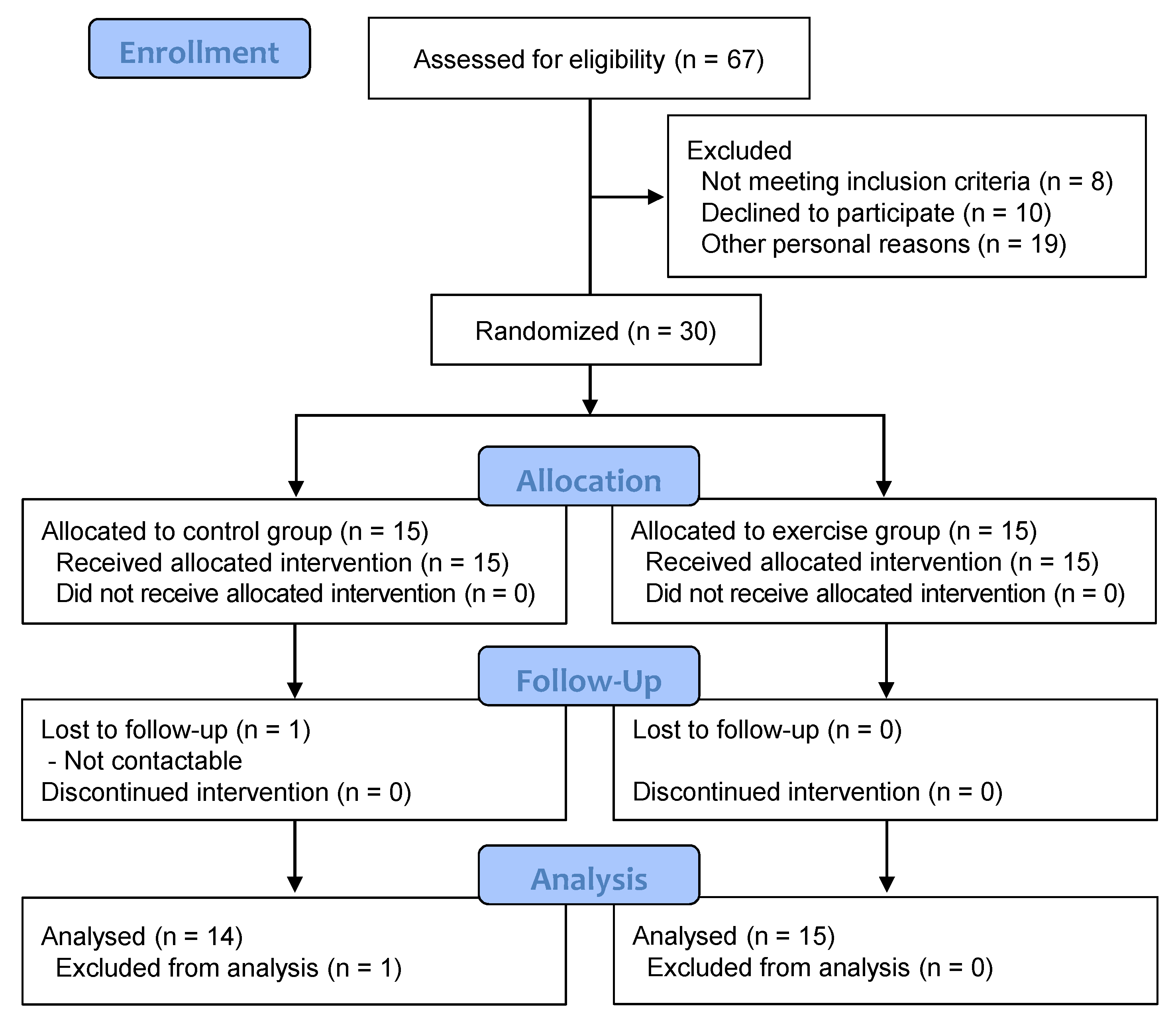
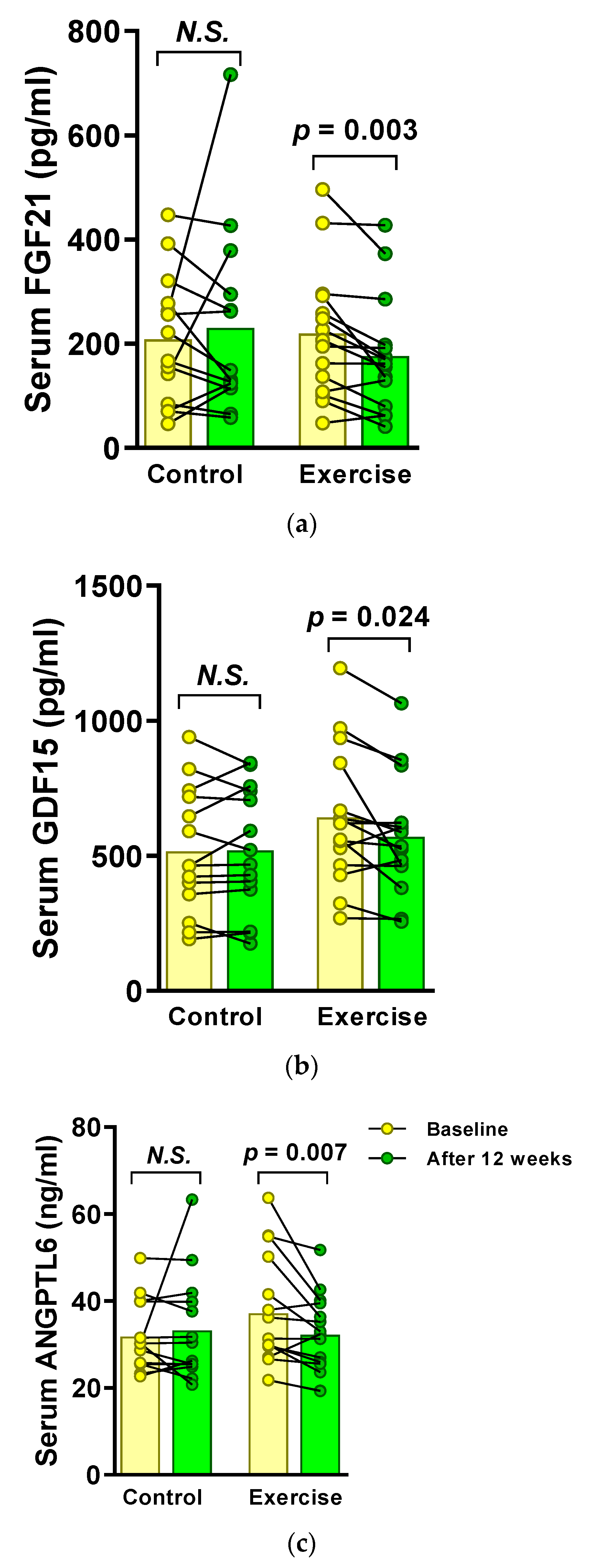
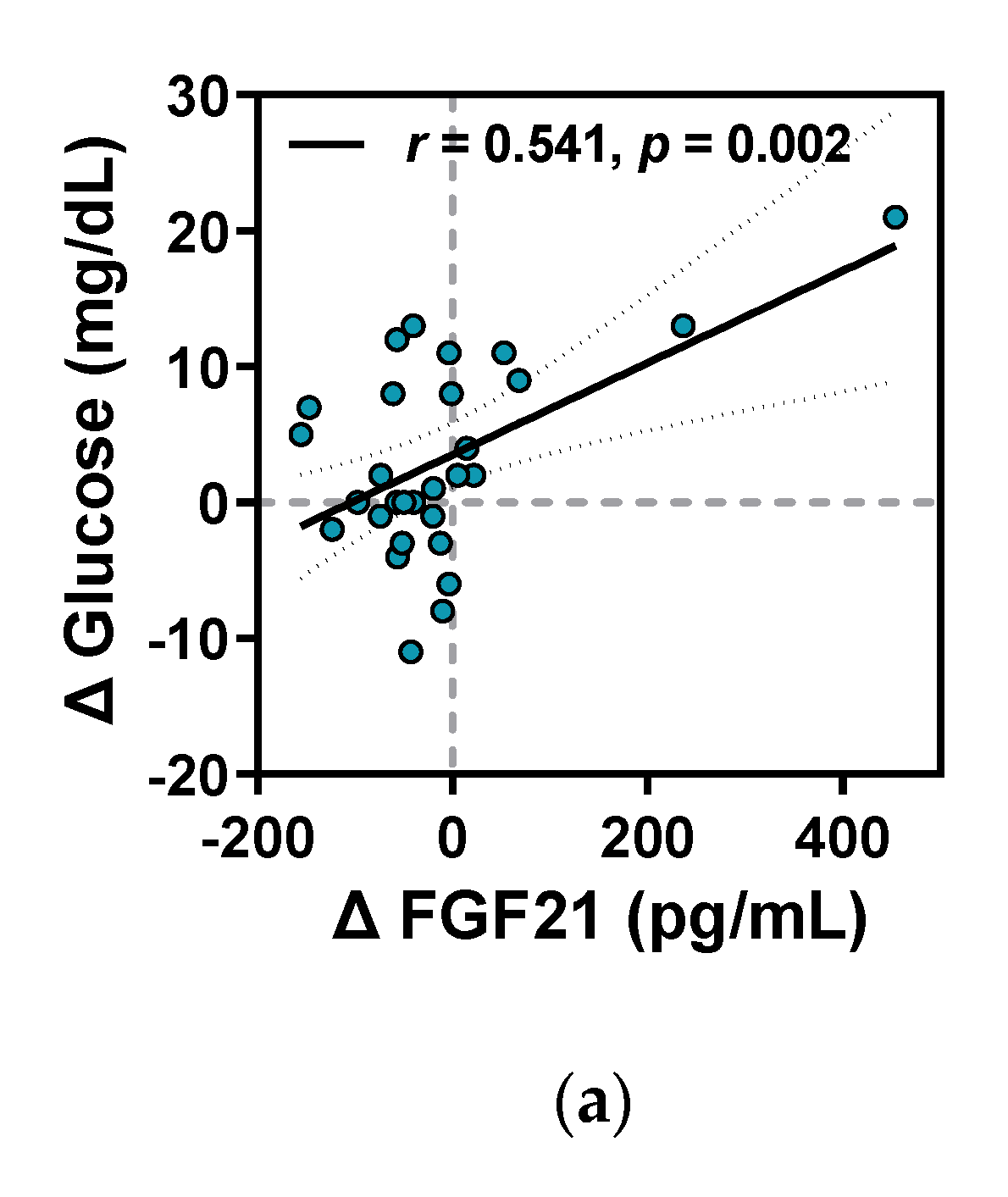

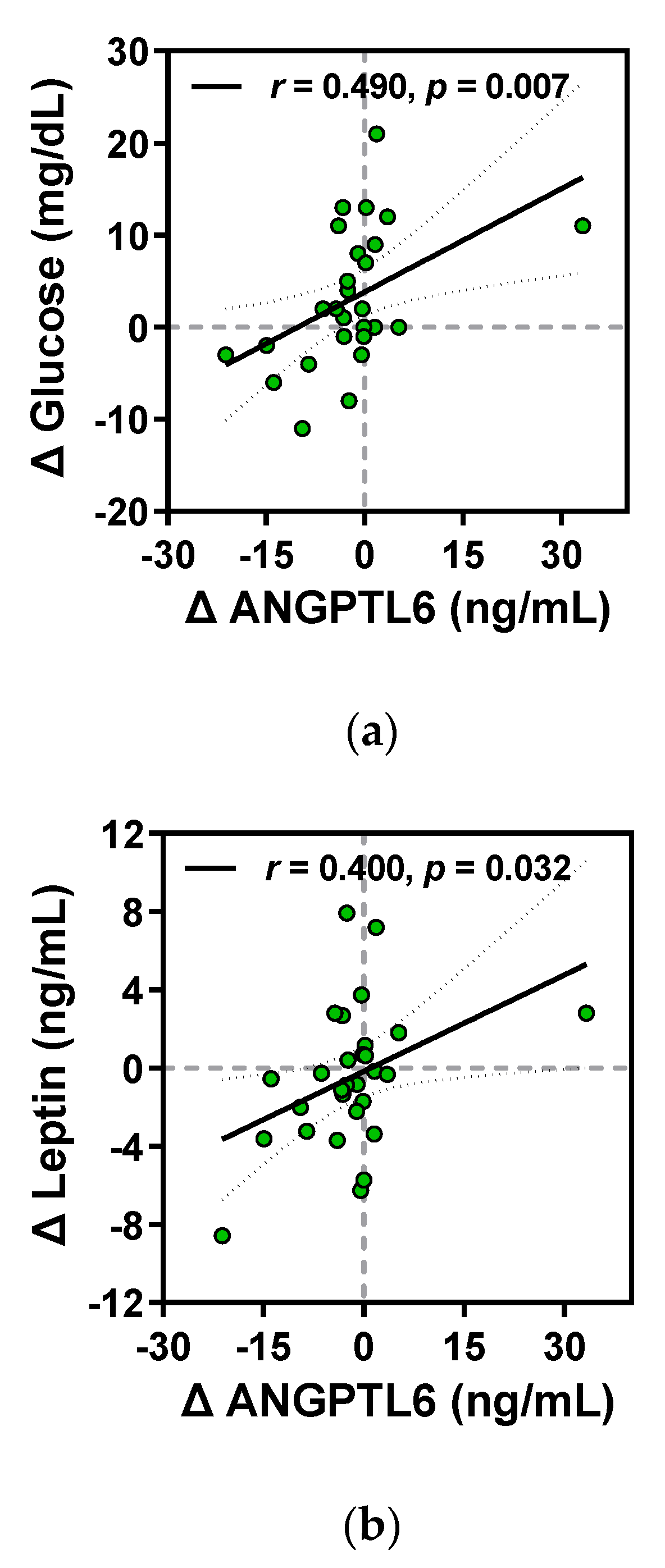
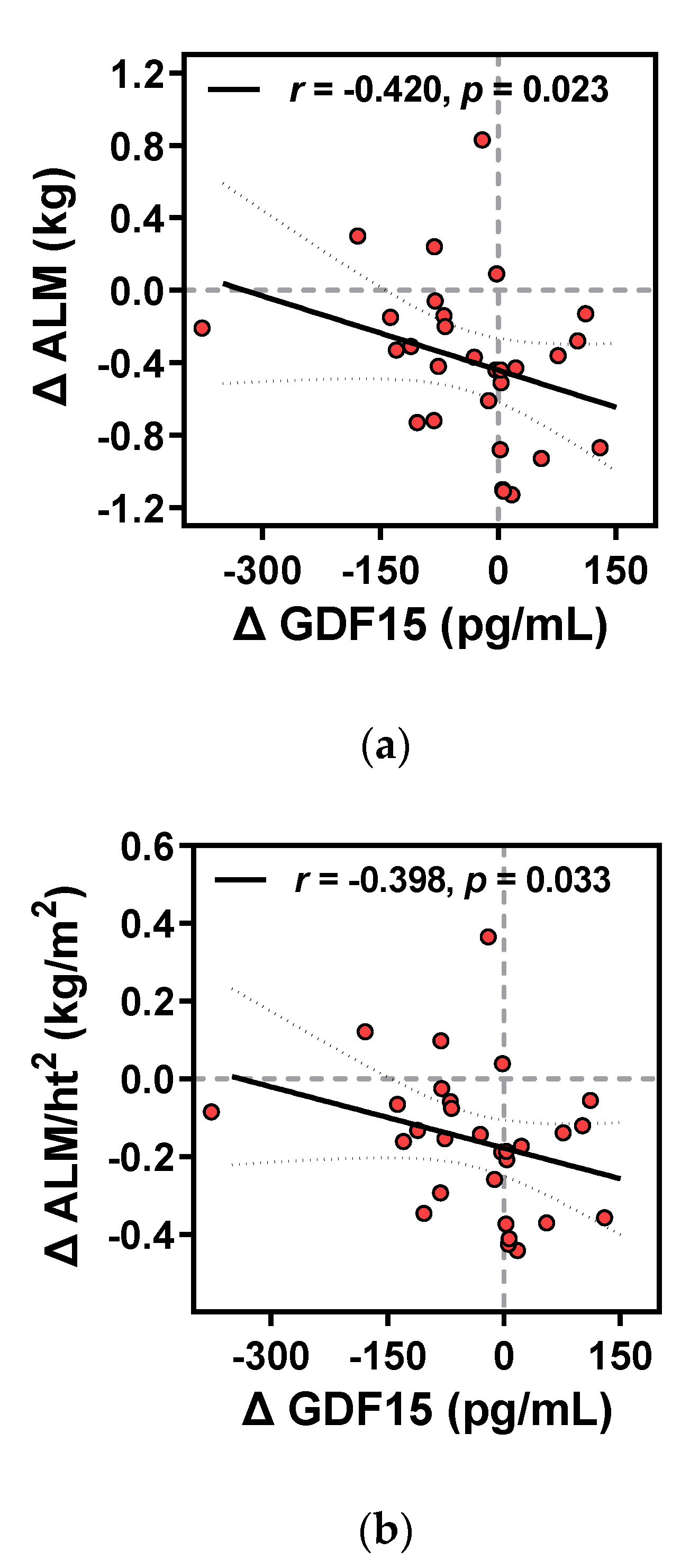
| Variables | Control Group (n = 14) | Exercise Group (n = 15) | ||
|---|---|---|---|---|
| Baseline | After 12 Weeks | Baseline | After 12 Weeks | |
| Age (years) | 57.5 ± 12.2 | – | 60.2 ± 7.9 | – |
| Height (cm) | 156.3 ± 5.1 | – | 154.8 ± 5.1 | – |
| Weight (kg) | 67.1 ± 11.7 | 66.3 ± 11.6 | 63.8 ± 8.6 | 59.4 ± 8.3 |
| Body mass index (kg/m2) | 29.5 ± 4.4 | 29.1 ± 4.3 | 28.9 ± 3.0 | 26.7 ± 2.9 * |
| Waist circumference (cm) | 91.7 ± 7.4 | 89.7 ± 7.5 | 89.6 ± 5.5 | 84.1 ± 4.3 * |
| Body fat (%) | 37.6 ± 6.0 | 38.3 ± 5.8 | 37.3 ± 5.5 | 34.9 ± 5.3 * |
| BFM (kg) | 25.6 ± 7.8 | 25.8 ± 7.7 | 21.4 ± 5.8 | 20.9 ± 5.6 |
| ALM (kg) | 16.9 ± 0.8 | 16.3 ± 0.7 * | 15.1 ± 0.6 | 15.5 ± 0.5 |
| ALM/BFM ratio | 0.700 ± 0.185 | 0.669 ± 0.184 * | 0.718 ± 0.168 | 0.753 ± 0.155 * |
| Systolic blood pressure (mmHg) | 132.6 ± 11.4 | 135.3 ± 14.2 | 131.3 ± 12.1 | 129.0 ± 13.5 |
| Diastolic blood pressure (mmHg) | 85.3 ± 10.6 | 85.4 ± 12.6 | 83.8 ± 10.6 | 82.3 ± 11.1 |
| Handgrip strength (kg) | 27.2 ± 4.8 | 27.5 ± 4.3 | 27.3 ± 3.9 | 28.7 ± 4.2 * |
| Long jump (cm) | 124.7 ± 23.1 | 118.3 ± 26.0 * | 116.1 ± 18.5 | 117.1 ± 10.4 |
| Sit-up (n/30 sec) | 11.4 ± 7.7 | 12.7 ± 7.8 | 9.3 ± 9.8 | 13.1 ± 8.3 * |
| 10 m shuttle run (sec) | 16.5 ± 1.9 | 16.4 ± 2.6 | 16.4 ± 2.1 | 15.7 ± 1.0 |
| 20 m pacer (n) | 10.2 ± 3.7 | 10.8 ± 4.4 | 9.4 ± 3.1 | 12.5 ± 3.4 * |
| Sit-and-reach (cm) | 13.9 ± 5.0 | 13.3 ± 3.3 | 13.9 ± 8.3 | 16.1 ± 7.1 * |
| Variables | Control Group (n = 14) | Exercise Group (n = 15) | ||
|---|---|---|---|---|
| Baseline | After 12 Weeks | Baseline | After 12 Weeks | |
| Triglyceride (mg/dL) | 116.0 (71.0–165.0) | 119.0 (87.0–155.0) | 139.5 (93.3–188.3) | 122.0 (82.8–174.0) |
| Total cholesterol (mg/dL) | 200.6 ± 29.4 | 195.2 ± 28.3 | 190.3 ± 26.8 | 176.5 ± 23.5 |
| HDL-cholesterol (mg/dL) | 45.0 (37.0–56.0) | 48.5(41.0–53.5) | 42.5 (40.0–45.5) | 51.0 (40.0–60.0) |
| LDL-cholesterol (mg/dL) | 141.8 ± 22.7 | 131.3 ± 24.8 | 130.6 ± 38.7 | 116.0 ± 39.0 |
| Fasting glucose (mg/dL) | 90.5 (85.0–104.8) | 95.5 (90.5–105.5) | 96.0 (88.0–109.0) | 94.0 (89.0–103.0) |
| Fasting insulin(µIU) | 5.80 (3.75–7.53) | 6.35 (4.9–11.3) | 5.30 (4.50–8.20) | 5.20 (4.00–7.50) |
| HOMA-IR | 1.21 (0.86–1.74) | 1.62 (1.09–2.83) | 1.22 (1.06–1.96) | 1.14 (0.92–1.74) |
| HOMA-β (%) | 69.4 (35.1–96.8) | 69.2 (45.6–144.9) | 56.3 (46.4–79.5) | 59.6 (52.4–78.3) |
| HbA1c (%) | 5.55 (5.38–5.73) | 5.65 (5.48–5.93) | 5.60 (5.40–6.00) | 5.50 (5.10–5.90) * |
| HbA1c (mmol/mol) | 37.4 ± 3.6 | 38.8 ± 3.5 | 39.3 ± 5.1 | 37.4 ± 4.9 * |
| Aspartate aminotransferase (IU/L) | 21.5 (16.8–25.3) | 24.0 (19.5–26.3) | 22.0 (20.0–26.0) | 22.0 (18.0–23.0) |
| Alanine aminotransferase (IU/L) | 20.0 (14.5–24.0) | 21.0 (18.3–25.8) | 18.0 (14.0–22.0) | 15.0 (14.0–17.0) |
| γ-glutamyltransferase (IU/L) | 21.0 (15.3–27.3) | 27 (16.5–34.5) * | 20.0 (11.0–25.0) | 16.0 (10.0–23.0) |
| Highly sensitive C-reactive protein (mg/L) | 0.86 ± 0.45 | 1.49 ± 1.06 * | 1.23 ± 2.35 | 1.02 ± 0.81 |
| Uric acid (mg/dL) | 5.10 ± 1.26 | 4.88 ± 1.32 | 4.74 ± 1.39 | 4.45 ± 1.06 |
| Leptin (ng/mL) | 10.09 (5.89–17.19) | 9.86 (6.89–20.37) | 7.83 (4.77–11.92) | 7.60 (3.57–9.03) * |
| Number of components of MetS | 4.2 (3.8–4.6) | 3.9 (3.3–4.4) | 4.1 (3.6–4.6) | 3.1 (2.4–3.7) * |
| 0 | – | – | – | – |
| 1 | – | – | – | 1 (6.7) |
| 2 | – | 1 (7.1) | – | 4 (26.7) |
| 3 | 2 (14.3) | 4 (28.6) | 5 (33.3) | 5 (33.3) |
| 4 | 7 (50.0) | 5 (35.7) | 4 (26.7) | 3 (20.0) |
| 5 | 5 (35.7) | 4 (28.6) | 6 (40.0) | 2 (13.3) |
| †P value | 0.306 | 0.025 | ||
Publisher’s Note: MDPI stays neutral with regard to jurisdictional claims in published maps and institutional affiliations. |
© 2021 by the authors. Licensee MDPI, Basel, Switzerland. This article is an open access article distributed under the terms and conditions of the Creative Commons Attribution (CC BY) license (http://creativecommons.org/licenses/by/4.0/).
Share and Cite
Chang, J.S.; Namkung, J. Effects of Exercise Intervention on Mitochondrial Stress Biomarkers in Metabolic Syndrome Patients: A Randomized Controlled Trial. Int. J. Environ. Res. Public Health 2021, 18, 2242. https://doi.org/10.3390/ijerph18052242
Chang JS, Namkung J. Effects of Exercise Intervention on Mitochondrial Stress Biomarkers in Metabolic Syndrome Patients: A Randomized Controlled Trial. International Journal of Environmental Research and Public Health. 2021; 18(5):2242. https://doi.org/10.3390/ijerph18052242
Chicago/Turabian StyleChang, Jae Seung, and Jun Namkung. 2021. "Effects of Exercise Intervention on Mitochondrial Stress Biomarkers in Metabolic Syndrome Patients: A Randomized Controlled Trial" International Journal of Environmental Research and Public Health 18, no. 5: 2242. https://doi.org/10.3390/ijerph18052242
APA StyleChang, J. S., & Namkung, J. (2021). Effects of Exercise Intervention on Mitochondrial Stress Biomarkers in Metabolic Syndrome Patients: A Randomized Controlled Trial. International Journal of Environmental Research and Public Health, 18(5), 2242. https://doi.org/10.3390/ijerph18052242






